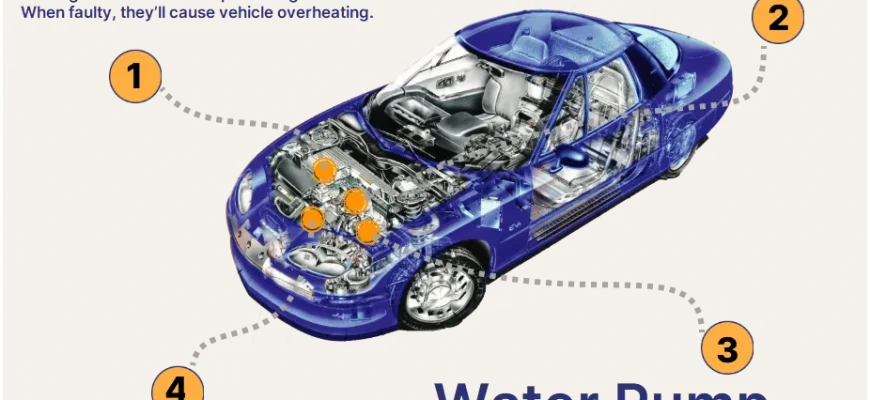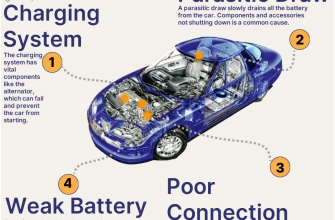Car overheating is a common issue that can lead to severe engine damage if not addressed promptly. While many drivers may associate overheating with high-speed driving or heavy loads, it’s equally important to understand that idling can also contribute to this problem. In this article, we will delve into the reasons why cars overheat while idling, the signs to look out for, and effective solutions to mitigate the risks.
- Why Does Overheating Occur While Idling?
- Signs Your Car is Overheating While Idling
- Preventive Measures to Avoid Overheating While Idling
- Addressing Overheating Issues: What to Do When Your Car Gets Hot
- 1. Turn Off the Engine
- 2. Check the Coolant Level
- 3. Inspect for Leaks
- 4. Evaluate the Cooling Fan
- 5. Look for Warning Lights
- 6; Seek Professional Help
- Final Thoughts
Why Does Overheating Occur While Idling?
When a vehicle is idling, the engine continues to run without the benefit of airflow generated by driving. Here are several key factors that can lead to overheating during these stationary periods:
- Insufficient Airflow: At idle, the engine cooling fan may not provide enough airflow to cool the radiator, especially in hot weather or during prolonged stops.
- Coolant Issues: Low coolant levels or old, ineffective coolant can hinder the engine’s cooling system. If the coolant is dirty or not circulating properly, it can lead to overheating.
- Thermostat Failures: The thermostat regulates the flow of coolant. A malfunction can prevent coolant from entering or exiting the engine, causing temperatures to rise rapidly.
- Water Pump Malfunction: The water pump is essential for circulating coolant throughout the engine. If it fails, the cooling system becomes ineffective, leading to overheating.
- Blocked Radiator: Accumulation of debris, dirt, or corrosion in the radiator can obstruct coolant flow, reducing its ability to dissipate heat.
Signs Your Car is Overheating While Idling
Recognizing the signs of overheating can help you take action before serious damage occurs. Here are some common symptoms:
- Temperature Gauge: A rising temperature gauge on your dashboard is the first indicator that your engine may be overheating.
- Warning Lights: Many modern vehicles are equipped with warning lights that illuminate when the engine temperature exceeds safe levels.
- Steam from the Engine: If you notice steam billowing from under the hood, this is a clear sign of overheating.
- Unusual Noises: Overheating can cause metal parts to expand and create unusual noises, such as knocking or hissing sounds.
- Burning Smell: A burning odor, particularly if accompanied by smoke, indicates that your engine is overheating.
Preventive Measures to Avoid Overheating While Idling
To prevent overheating issues while idling, consider these preventive measures:
- Check Coolant Levels: Regularly inspect and maintain proper coolant levels to ensure efficient cooling.
- Service the Cooling System: Have your cooling system, including the radiator, thermostat, and water pump, inspected and serviced as needed.
- Monitor Engine Temperature: Pay close attention to your temperature gauge, especially during extended idling periods.
- Limit Idle Time: Whenever possible, avoid excessive idling. Turn off the engine if you anticipate waiting for an extended period.
- Use the Air Conditioning Wisely: Using air conditioning can increase engine load, so use it judiciously during idling.
Understanding the causes and symptoms of car overheating while idling is crucial for any driver. By staying vigilant and following preventive measures, you can help ensure your vehicle remains in optimal condition. Always remember, if your vehicle exhibits signs of overheating, it’s essential to address the issue immediately to prevent costly repairs and ensure your safety on the road.
Addressing Overheating Issues: What to Do When Your Car Gets Hot
When your vehicle starts to exhibit signs of overheating, especially during idling, it’s crucial to respond quickly and effectively. Ignoring these symptoms can lead to catastrophic engine failure and costly repairs. Here are some proactive steps you can take if you find yourself in this situation:
1. Turn Off the Engine
The first and most important step when you notice your car overheating is to turn off the engine. Continuing to run an overheated engine can exacerbate the problem, leading to more significant damage. Find a safe place to pull over, turn off the ignition, and allow the engine to cool down.
2. Check the Coolant Level
Once the engine has cooled, check the coolant reservoir. If the coolant level is low, it could be a sign of a leak or that the system needs a refill. Only open the coolant reservoir cap when the engine is cool to avoid burns from steam or hot coolant. If you need to refill, use the appropriate type of coolant for your vehicle.
3. Inspect for Leaks
While you’re checking the coolant, take a moment to inspect for any visible leaks under the vehicle. Look for puddles of coolant or signs of wetness around hoses and connections. If you find a leak, you may need to have it repaired before you can safely drive the car again.
4. Evaluate the Cooling Fan
Check if the cooling fan is functioning properly. You can do this by turning on the ignition (without starting the engine) and observing whether the fan kicks on. If it doesn’t, there may be an issue with the fan motor, relay, or wiring, all of which may require professional attention.
5. Look for Warning Lights
Take note of any warning lights on your dashboard. Many modern vehicles are equipped with sensors that will alert you to overheating or other issues. If a warning light is illuminated, consult your owner’s manual to determine the best course of action.
6; Seek Professional Help
If after taking these steps your vehicle continues to show signs of overheating, it’s time to consult a mechanic. Continuing to drive an overheating vehicle can cause permanent damage, so it’s best to err on the side of caution. A professional can conduct a thorough diagnostic to identify underlying issues, such as a faulty water pump, clogged radiator, or thermostat failure.
Final Thoughts
Understanding the causes and implications of car overheating while idling is essential for every driver. Regular maintenance, including checking coolant levels, inspecting the cooling system, and being aware of your vehicle’s temperature gauge, can help prevent these issues from arising. By taking preventive measures and knowing how to respond when overheating occurs, you can safeguard your vehicle’s performance and longevity, ensuring that your journeys remain smooth and worry-free.
Remember, a little knowledge and preparation can go a long way in maintaining your vehicle and keeping it in top shape for all your adventures on the road.










I never realized that idling could lead to overheating. This article is a must-read for all drivers to prevent engine damage.
I appreciate how this article highlights the importance of regular maintenance. It’s time to check my coolant levels!
Great insights! The signs of overheating were well explained, and I now feel more prepared to handle potential issues with my car.
Informative read! The breakdown of causes for overheating during idling was very helpful. I
This article provides a clear explanation of why cars can overheat while idling. I learned so much about the importance of coolant and airflow!